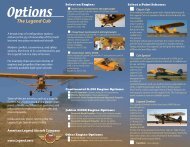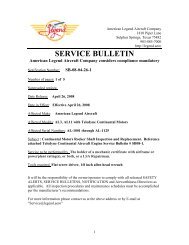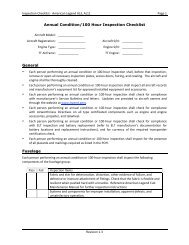Lycoming Flyer - Aircrafts sales, engines repair, spare parts
Lycoming Flyer - Aircrafts sales, engines repair, spare parts
Lycoming Flyer - Aircrafts sales, engines repair, spare parts
- No tags were found...
You also want an ePaper? Increase the reach of your titles
YUMPU automatically turns print PDFs into web optimized ePapers that Google loves.
overhaul will probably determine the possibilities of achievinga full TBO. Consider that most overhaulers install reconditionedcylinders on the <strong>engines</strong> they overhaul. These cylinders are nottraceable. There is no requirement to maintain a record of theirprevious history. They may have only 2000 hours of operation,but they could just as easily have 5000, 7000 or more hours ofoperation. Those cylinders may have been cracked and <strong>repair</strong>edby welding — a procedure that <strong>Lycoming</strong> metallurgists do notrecommend because the strength of a <strong>repair</strong>ed cylinder headmay be significantly less than that of a new head. There is norequirement to let a prospective engine buyer know if cylindershave been welded, and this cannot be determined even by closeexamination. The possibility of finding a reconditioned cylinderwith cracks after a few hundred hours of operation is very real.Should this happen, it will be a costly experience.The lesson to be learned here is a very old one — “BuyerBeware.” Whether you are looking at those “Aircraft for Sale”advertisements or looking for a replacement engine for an aircraftyou already own, consider carefully what you are about to buy.What do you really know about the engine other than the low-timenumber? How much validity does that number really have? Whatquestions can you ask which may help you ensure this engine willmeet your expectations?Perhaps simply rereading the paragraphs you have just read mayhelp you to formulate questions you want answered before takingthe plunge. In the case of a low-time engine with a history ofinfrequent flight, borescope examination of the cylinders andan inspection of cam and tappet surfaces by a competent andknowledgeable A & P mechanic would be a very wise move.Always remember that low numbers in the hours of operationrecords do not guarantee reaching TBO with many long hours oftrouble-free operation. The buyer must investigate every detailof engine history as closely as possible, and be satisfied that theproduct does have the value which the low hours of operationnumber suggests.Like ducts in a heating system, the baffles and seals of anengine compartment form a channel that’s designed to transportair from one location to another along a prescribed route.In this case, the “duct” funnels ram air through the enginecompartment and back out into the slipstream, cooling downheat-sensitive components in the process. Faulty or improperlyperforming baffles and seals, like a leaky duct, are inefficientand apt to cause damage to your assets.“Both are critical to cooling your engine,” says aviation columnistand former Shell Oil chemist, Ben Visser. Commonengine problems related to faulty baffles and seals includeabnormally high cylinder head temperatures, sticking valvesand spark plug overheating.To understand the importance of the function of baffles andseals, Visser says you first have to grasp the physical processof how an air-cooled engine is cooled. He explains that whenan aircraft is flying, air enters the cowling and is slowed in theplenum formed by the cowling, engine, baffles and seals. Theeffect creates a static, or higher pressure area, above the engine.Since gasses move from high pressure to low pressure, the airthen flows down through the cylinders and across the oil coolerto the low-pressure areas below and behind the engine. The airexits the cowling through cowl flaps or other flaring openings,carrying away excess heat.If the baffles are broken or misshapen, Visser says the deformitycan reduce the volume of air passing some or all of the cylinders,meaning less than expected cooling for the cylinders or for theoil cooler. Seals can create similar problems. Visser says if theseals are not in good condition or are not properly adjusted, aircan “bleed up” and reduce the static pressure, slowing the flowof cooling air and increasing engine temperatures.Higher engine temperatures can foreshadow trouble tocome. <strong>Lycoming</strong> says that if cooling air is not “adequatelycontained and directed, hot spots which promote a lead or carbonbuildup” on the valve guides can occur, potentially leadingto valve sticking problems during startup. Paul McBride, aka“Mr. <strong>Lycoming</strong>,” says a stuck valve most of the time ends upbending a push rod and causing an oil leak, but can also cause alarge reduction in engine power and very expensive damage tothe crankcase. McBride, now an aviation columnist and lecturer,retired from <strong>Lycoming</strong> after a four-decade career.Other problems with insufficient cooling include overheatingthe spark plug barrels, a problem that deteriorates ignition leadsand boosts temperatures in the insulator tip high enough to causepreignition and piston distress. <strong>Lycoming</strong> points out that adequateair flow is particularly important during hot weather in orderto provide proper cooling of the oil cooler; oil that runs too hotbreaks down and causes more friction inside the engine.Visser recommends having the baffles checked any time theengine is being serviced or before a new engine is installed. Theseals, he says, should be checked during periodic inspections.While the first step in diagnosing abnormal engine temperaturesin normal operations is making sure the temperature gauge isproviding accurate readings — a problem that mechanics sayaccounts for most of the high temperature complaints — Vissersays the next step is to check all the seals for fit and condition. “Ifthe seals aren’t soft and pliable, replace them,” he says.One way to observe how well the seals are performing theirstop-gap function is to remove the cowling and look at theresidues left where the cowling and seals rub together. Vissersays having one continuous line of smudge means the seal isdoing its job. If there are breaks in the line — which might showup as unmarked area where the air was rushing through thegap — that could mean leaks and lower static pressure above theengine. Visser also recommends inspecting cowl flaps or flaringopenings at the rear of the cowling for excessive leakage, indicatedby discoloration.If high cylinder head temperatures continue to be problematic,<strong>Lycoming</strong> suggests having the ignition and fuel systemsinspected for problems.L y c o m i n g F l y e r 3 1









